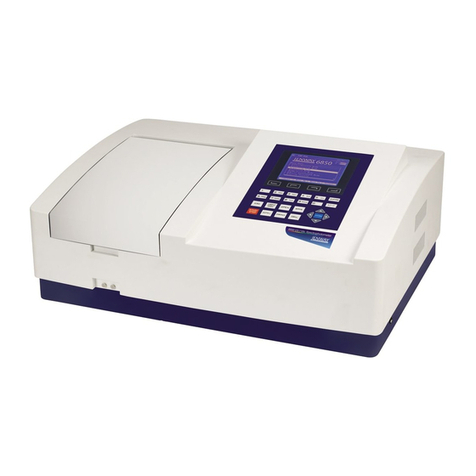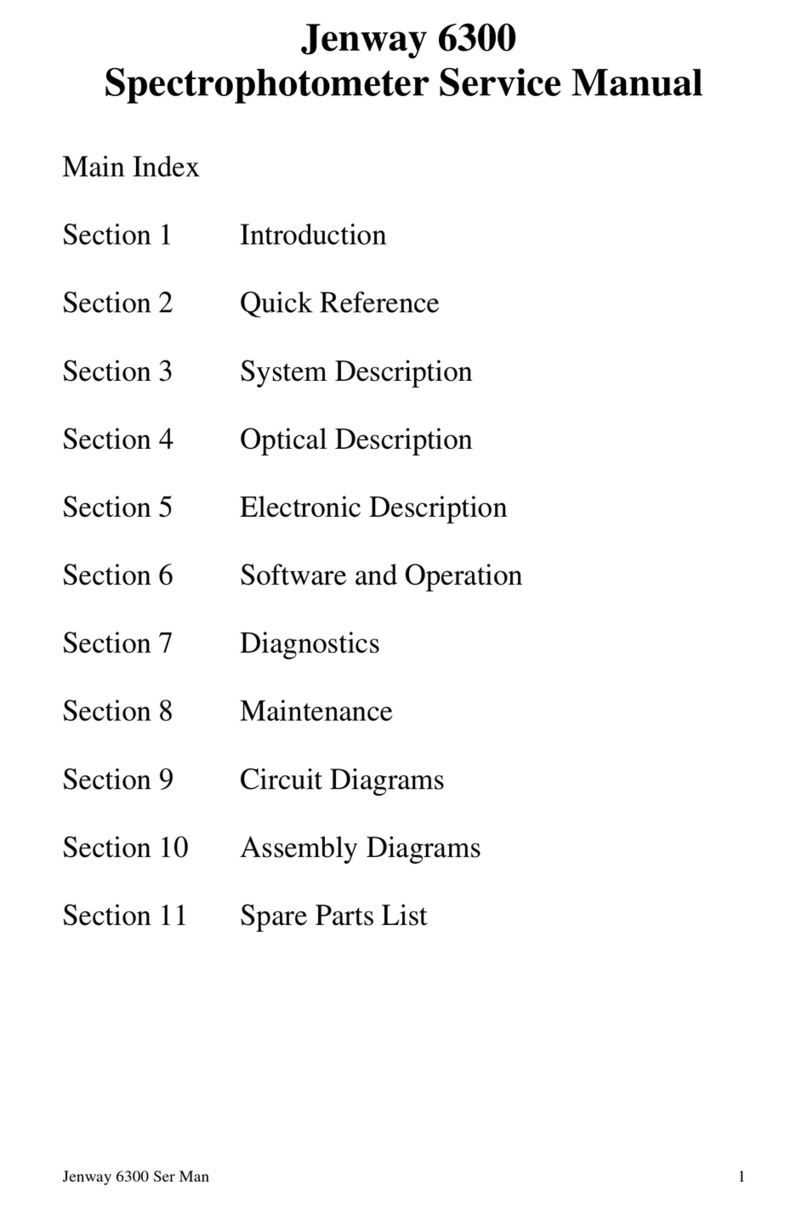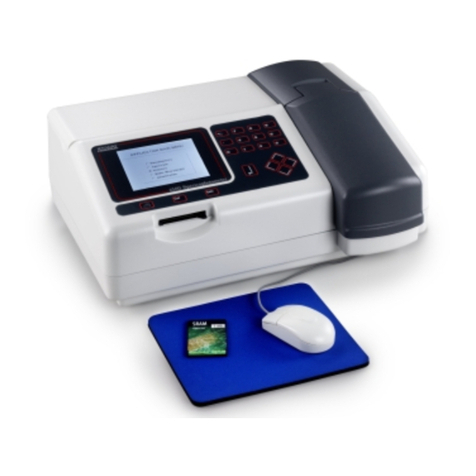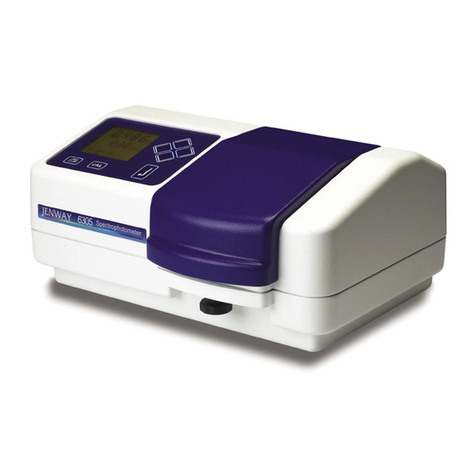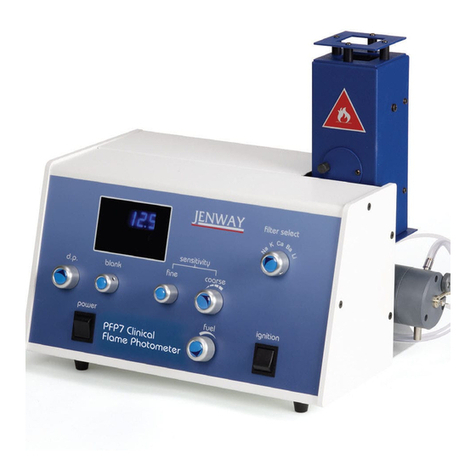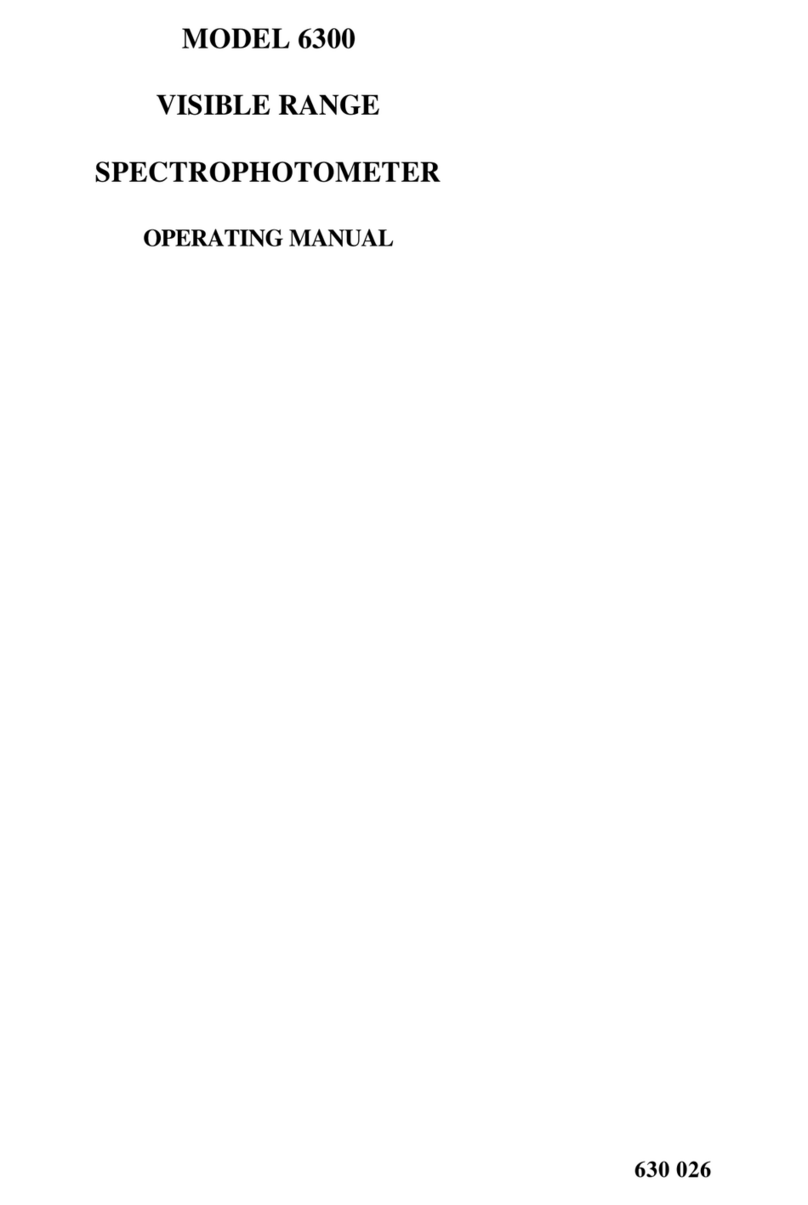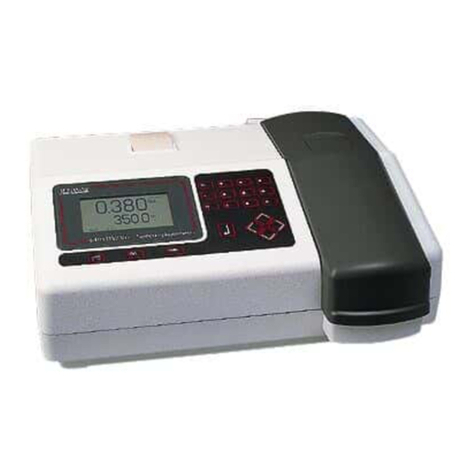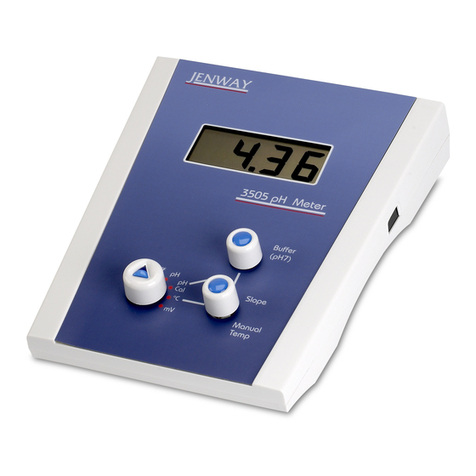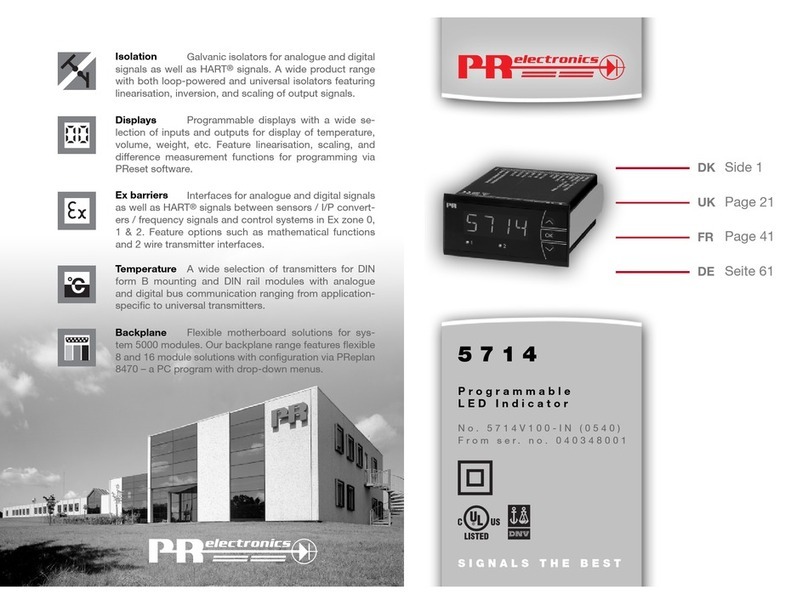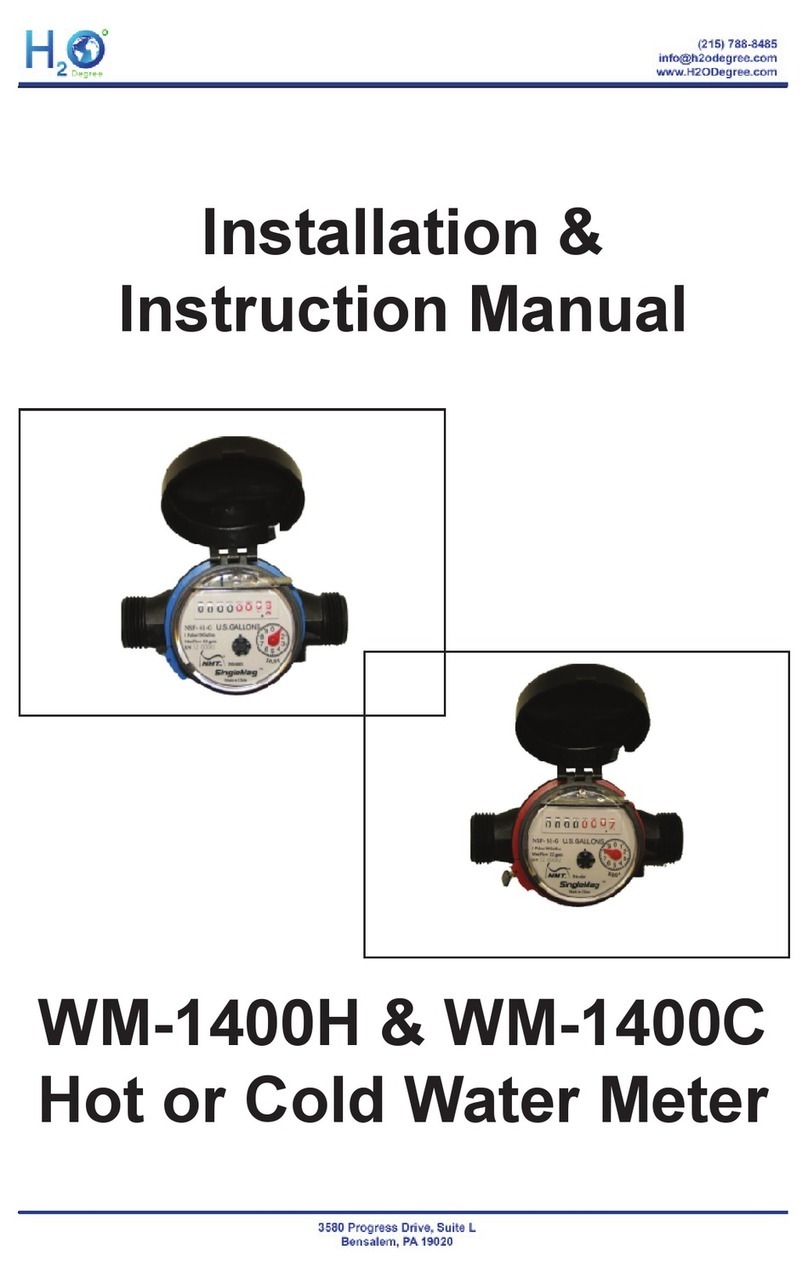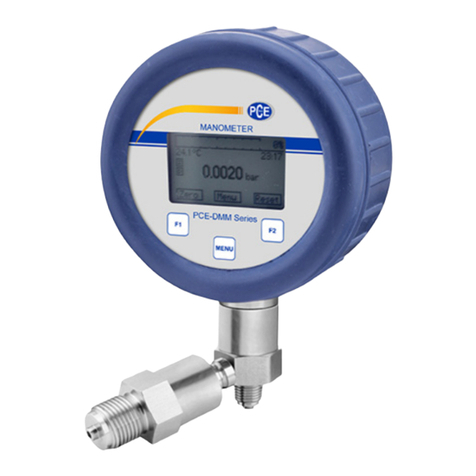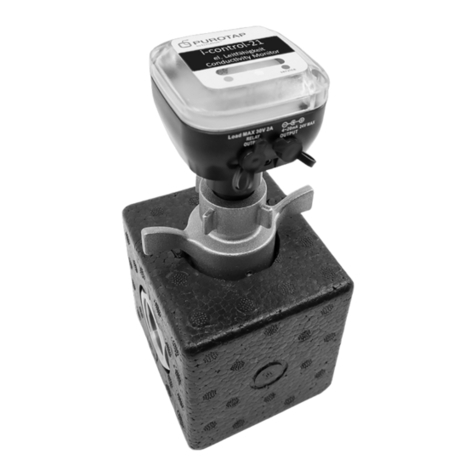jenway 7300 User manual

Operating Manual
730 005 REV D/08-14
Model 7300 and 7305
Spectrophotometer

2

3
Safety
Please read this information carefully prior to installing or using this equipment.
1. The unit described in this manual is designed be operated only by trained personnel. Any
adjustments, maintenance and repair must be carried out as defined in this manual, by a
person qualified to be aware of the hazards involved.
2. It is essential that both operating and service personnel employ a safe system of work, in
addition to the detailed instructions specified in this manual.
3. Other than for those items defined in the maintenance procedures herein there are no user
serviceable items in this instrument. Removal of covers and attempted adjustment or service
by unqualified personnel will invalidate the warranty and may incur additional charges for
repair.
4. References should always be made to the Health and Safety data supplied with any
chemicals used. Generally accepted laboratory procedures for safe handling of chemicals
should be employed.
5. If it is suspected that safety protection has been impaired in any way, the unit must be made
inoperative and secured against any intended operation. The fault condition should
immediately be reported to the appropriate servicing authority.
Merci de lire attentivement ces informations avant d'installer ou d'utiliser cet appareil.
1. L'appareil décrit dans ce manuel est conçu pour être utilisé uniquement par des personnes
formées. Tout réglage, maintenance ou réparation doit être effectué comme décrit dans ce
manuel, par une personne qualifiée consciente des risques encourus.
2. Il est essentiel que les personnes utilisant et intervenant sur cet appareil respectent les
règles de sécurité de travail, en plus des instructions détaillées précisées dans ce manuel.
3. En-dehors des éléments décrits dans les procédures de maintenance ci-incluses, cet
appareil ne contient aucun élément réparable par l'utilisateur. L'enlèvement des capots et les
tentatives de réglage ou de réparation par des personnes non qualifiées invalide toute
garantie et entraîne un risque de frais de réparation supplémentaires.
4. Toujours se référer aux fiches techniques de santé et de sécurité accompagnant tout produit
chimique utilisé. Respecter les procédures de laboratoire généralement acceptées pour la
manipulation en toute sécurité des produits chimiques.
5. Si l'utilisateur suspecte qu'un problème quelconque puisse mettre en cause la sécurité,
l’appareil doit être rendu inopérant en empêchant son utilisation. Communiquer la défaillance
constatée au service de maintenance compétent.

4
Bitte lesen Sie diese Hinweise vor Installation oder Gebrauch dieser Ausrüstung sorgfältig
durch.
1. Das in diesem Handbuch beschriebene Gerät darf nur von geschultem Personal bedient
werden. Alle Anpassungen, Wartungsarbeiten und Reparaturen müssen entsprechend der
Vorgaben in diesem Handbuch und von einer kompetenten Person, die mit den damit
verbundenen Gefahren vertraut ist, durchgeführt werden.
2. Es ist wichtig, dass sowohl das Bedienungs- als auch das Service-Personal zusätzlich zu den
detaillierten Anweisungen in diesem Handbuch ein sicheres Arbeitssystem einsetzen.
3. Mit Ausnahme der Teile, deren Wartungsverfahren in diesem Handbuch beschrieben sind,
enthält dieses Gerät keine weiteren Teile, die vom Benutzer gewartet werden können. Das
Entfernen von Abdeckungen und Versuche von hierfür unqualifiziertem Personal,
Anpassungen oder Wartungsarbeiten durchzuführen, haben zur Folge, dass die Garantie
verfällt und können zusätzliche Reparaturkosten auslösen.
4. Es ist jederzeit auf die sicherheitsrelevanten Daten sämtlicher verwendeter Chemikalien
Bezug zu nehmen. Allgemein anerkannte Labormethoden zum sicheren Umgang mit
Chemikalien sollten eingesetzt werden.
5. Besteht der Verdacht, dass die Sicherheitsvorrichtungen in irgendeiner Weise beschädigt
wurden, muss das Gerät außer Betrieb genommen und gegen weiteren Gebrauch gesichert
werden. Die Störung sollte der zuständigen Serviceeinrichtung unverzüglich gemeldet
werden.
Leggere attentamente queste istruzioni prima di installare o utilizzare il dispositivo.
1. L'unità descritta nel presente manuale è stata realizzata per essere utilizzata solo da
personale che ha ricevuto l'apposita formazione. Qualsiasi operazione di regolazione,
manutenzione e riparazione deve essere effettuata sulla base di quanto indicato nel presente
manuale da personale qualificato consapevole dei rischi connessi.
2. È fondamentale che il personale operativo e il personale addetto alla manutenzione utilizzino
un sistema di lavoro sicuro, oltre a seguire le istruzioni specificate nel presente manuale.
3. Oltre a quelli indicati nelle procedure di manutenzione, all'interno di questo dispositivo non
sono presenti altri elementi sui quali è possibile effettuare interventi. La rimozione delle
protezioni e qualsiasi tentativo di regolazione o di manutenzione posto in essere da
personale non qualificato invaliderà la garanzia. In questi casi, sarà necessario pagare un
importo per le riparazioni effettuate.
4. È sempre necessario fare riferimento ai dati sulla salute e sulla sicurezza forniti con le
sostanze chimiche utilizzate. Adottare le procedure di laboratorio generalmente accettate per
la gestione delle sostanze chimiche.

5
5. Nel caso in cui si sospetti che la salute possa essere pregiudicata in qualsiasi modo,
disattivare l'unità per renderla inutilizzabile. Qualsiasi condizione di errore deve essere
immediatamente segnalata al responsabile per la manutenzione.
Lea esta información atentamente antes de instalar o utilizar este equipo.
1. La unidad descrita en este manual está diseñada para que solamente la utilice personal con
formación. Cualquier operación de ajuste, mantenimiento y reparación debe llevarse a cabo
del modo indicado en este manual y debe realizarla una persona cualificada que sea
consciente de los peligros que implica.
2. Es fundamental que tanto los operarios como el personal de servicio utilicen un sistema de
trabajo seguro, así como las instrucciones detalladas que se especifican en este manual.
3. Cualquier elemento que no se encuentre entre los definidos en los procedimientos de
mantenimiento aquí descritos no podrá utilizarse en este instrumento. La extracción de las
tapas y los intentos de ajuste o reparación por parte de personal no cualificado invalidarán la
garantía y pueden incurrir en cargos adicionales por reparación.
4. Siempre deberían consultarse los datos sobre Salud y Seguridad que se suministran con
cualquier producto químico que se utilice. Es necesario llevar a cabo los procedimientos de
laboratorio de aceptación generalizada para la manipulación segura de productos químicos.
5. Si existe la sospecha de que las medidas protectoras de seguridad han quedado dañadas en
cualquier modo, la unidad debe inutilizarse y protegerse contra toda operación que se intente
llevar a cabo. El estado de fallo debe comunicarse inmediatamente a la autoridad de servicio
de mantenimiento y reparación pertinente.

6
Contents
Safety.........................................................................................................................3
Contents.....................................................................................................................6
SECTION 1 - Introduction ..........................................................................................8
1.1 INSTRUMENT DESCRIPTION............................................................................................. 8
1.2 INSTRUMENT SPECIFICATION.......................................................................................... 8
SECTION 2 –Installation...........................................................................................9
2.1 UNPACKING......................................................................................................................... 9
2.2 INSTALLATION.................................................................................................................... 9
2.3 DISPLAY............................................................................................................................. 10
2.4 CONTROLS........................................................................................................................ 11
2.5REAR PANEL..................................................................................................................... 12
2.6 FRONT PANEL................................................................................................................... 12
SECTION 3 –Theory and Practice of Spectroscopy Measurements.......................13
3.1 THEORY OF SPECTROSCOPY MEASUREMENT .......................................................... 13
3.2 SPECTROSCOPY MEASUREMENT................................................................................. 14
3.3 GOOD PRACTICE GUIDELINES....................................................................................... 15
SECTION 4 –Instrument Setup...............................................................................17
4.1 NAVIGATING AND SCREEN SETUP................................................................................ 17
4.2 TIME AND DATE................................................................................................................ 18
4.3 INSTRUMENT SETTINGS MENU...................................................................................... 18
4.4 SCREEN CONTRAST........................................................................................................ 19
4.5 LAMP SAVE........................................................................................................................ 19
SECTION 5 –PHOTOMETRICS .............................................................................21
5.1 MODE SPECIFIC PARAMETERS ..................................................................................... 21
5.2 METHOD SET UP .............................................................................................................. 21
5.2.1 Selecting a Wavelength...................................................................................................... 21
5.3 CALIBRATION.................................................................................................................... 22
5.4 SAMPLE MEASURMENT................................................................................................... 22
SECTION 6 –CONCENTRATION...........................................................................23
6.1 MODE SPECIFIC PARAMETERS ..................................................................................... 23
6.2 METHOD SETUP ............................................................................................................... 23
6.2.1 Selecting a Wavelength...................................................................................................... 23
6.2.2 Settings............................................................................................................................... 24
6.2.2.1 Selecting Concentration Units ............................................................................................ 25
6.2.2.2 Changing the Resolution .................................................................................................... 25
6.2.2.3 Using a Standard................................................................................................................ 25
6.2.2.4 Using a Factor .................................................................................................................... 26
6.3 CALIBRATION.................................................................................................................... 26
6.3.1 Calibrating to a Standard.................................................................................................... 26
6.3.2 Calibrating to a Factor ........................................................................................................ 27
6.4 SAMPLE MEASUREMENT................................................................................................ 27
6.4.1 Measuring a Sample After Calibrating to a Standard......................................................... 27

7
6.4.2 Measuring a Sample After Calibrating to a Factor ............................................................. 28
6.5 POST MEASUREMENT OPTIONS.................................................................................... 28
6.5.1 Changing Concentration Units............................................................................................ 28
6.5.2 Changing the Concentration Factor.................................................................................... 29
6.5.3 Changing the Calibration Standard Value .......................................................................... 29
SECTION 7 –PRINTING AND AUTOLOGGING.....................................................30
7.1 PRINTING........................................................................................................................... 30
7.1.1 Print Setup.......................................................................................................................... 30
7.1.2 Printing Results................................................................................................................... 31
7.2 AUTOLOGGING................................................................................................................. 31
7.2.1 Setting the Number of Sample Repetitions ........................................................................ 31
7.2.2 Selecting Result’s Destination ............................................................................................ 32
7.3 CONNECTING TO A PC.................................................................................................... 33
SECTION 8 –Accessories and Spare Parts............................................................34
8.1 OPTIONAL ACCESSORIES............................................................................................... 34
8.2 CONNECTING THE ACCESSORIES ................................................................................ 34
8.2.1 Internal Printer .................................................................................................................... 34
8.2.2 Passive Accessories........................................................................................................... 35
8.2.2.1 Water-heated cuvette holder .............................................................................................. 35
8.2.3 Active Accessories.............................................................................................................. 38
8.2.3.1 Automatic 8 cell turret......................................................................................................... 39
8.2.3.2 Peltier.................................................................................................................................. 40
8.2.3.3 Sipper pump ....................................................................................................................... 41
8.2.3.4 Combined sipper Peltier pump ........................................................................................... 43
8.3 USING THE ACCESSORIES............................................................................................. 44
8.3.1 Automatic 8 cell turret......................................................................................................... 44
8.3.2 Peltier.................................................................................................................................. 44
8.3.3 Sipper pump ....................................................................................................................... 45
8.3.3.1 Manual Sipper Pump Settings............................................................................................. 46
8.3.3.2 Timed Sipper Pump Settings............................................................................................... 47
8.3.4 Combined sipper Peltier pump ........................................................................................... 50
8.4 SPARES ............................................................................................................................. 50
SECTION 9 –Maintenance and Service..................................................................51
9.1 ROUTINE MAINTENANCE ................................................................................................ 51
9.2 LAMP REPLACEMENT...................................................................................................... 51
9.2.1 Tungsten Halogen Lamp Replacement.............................................................................. 51
9.2.2 Xenon Lamp Module Replacement .................................................................................... 52
9.3 SERVICE............................................................................................................................ 52
SECTION 10 –Troubleshooting...............................................................................53
10.1 ERROR CODES................................................................................................................. 53
10.2 TROUBLESHOOTING GUIDE........................................................................................... 55
10.3 TECHNICAL SUPPORT..................................................................................................... 55
SECTION 11 –Declaration of Conformity................................................................56

8
SECTION 1 - Introduction
1.1 INSTRUMENT DESCRIPTION
The 7300 and 7305 spectrophotometers are suited to a wide range of applications in education,
quality control, environmental and clinical analysis. The 7300 is a visible spectrophotometer covering
a wavelength range from 320nm to 1000nm. The 7305 is a UV/Visible spectrophotometer with a
wavelength range from 198nm to 1000nm. Both models feature measurement modes for absorbance,
% transmittance and concentration. These instruments use icon driven software and have an
improved navigation system for easy and intuitive usability.
1.2 INSTRUMENT SPECIFICATION
7300
7305
Wavelength
Range
320 to 1000nm
198 to 1000nm
Resolution
1nm
Accuracy
± 2nm
Repeatability
± 0.5nm
Spectral bandwidth
5nm
Photometrics
Transmittance
0 to 199.9%
Absorbance
-0.300 to 2.500A
Accuracy
±1%T, ±0.01Abs at 1.000 Absorbance
Resolution
0.1%T, 0.001A
Stray light
<0.5% at 340nm
<0.5% at 340nm and 220nm
Stability
<0.002Abs/hr after 30 minute
warm up
<0.001Abs/hr without warm up
Concentration
Range
-300 to 9999
Resolution
Selectable 1/0.1/0.01/0.001
Calibration
Blank with a single standard or factor
Units
no units, %, ppm, EBC, SRM, mEq/l, mEq, M, mM, µM, nM, U, U/l,
U/ml, g/l, mg/l, µg/l, ng/l, g/dl, mg/dl, µg/dl, mg/ml, µg/ml, ng/ml, µg/µl,
ng/µl, mol/l, mmol/l
Factor
0.001 to 10000
Standard
0.001 to 1000
Other
Beam height
15mm
Light source
Tungsten halogen lamp
Xenon lamp
Lamp save
Yes
Not applicable
GLP
Current time and date
Outputs
Analogue, RS232, Internal printer
Power
24V
Size (w x d x h)
275 x 400 x 220mm
Weight
6kg

9
SECTION 2 –Installation
2.1 UNPACKING
Remove the 7300 or 7305 from the packaging and ensure the following items are included:
1. Model 7300 spectrophotometer (730 001), or Model 7305 spectrophotometer (730 501)
2. 24V 65W power supply unit (021 060)
3. 7300 - Pack of 100 disposable plastic visible wavelength cuvettes (060 084),
7305 - Pack of 100 disposable UV plastic cuvettes (060 230)
4. Jenway 73 series PC software (735 100) and interface cable (013 203)
5. Instruction manual (730 005)
6. Jenway Foreign Manual CD (JENMANCD)
7. Optional accessories (as ordered)
2.2 INSTALLATION
Models 7300 and 7305 are supplied ready to use.
The unit should be placed on a clean flat surface which is free from drafts and vibrations. The units
are designed for operation on 90V to 264V AC input at 47 to 63Hz. Select the correct plug attachment
and attach to the power supply unit as shown below:
Fig 2.2.1 –Power supply unit with various plugs
Connect the power supply unit to the power inlet socket on the rear panel of the instrument and
connect to the mains socket. Turn the power on at the mains and switch the instrument on using the
power switch on the rear of the instrument.

10
The instrument will perform several power on tests before displaying the main menu:
Fig 2.2.2 –All Power On Tests Complete
1. Instrument check –ensures the validity of the saved parameters
2. Dark test
3. Checks for the accessory fitted. If an active accessory is found the instrument verifies
communication and response
4. Self calibration of wavelengths
2.3 DISPLAY
These spectrophotometers have a dot matrix display which enables icons to be displayed
clearly. Following successful completion of the power on tests the main menu screen will be
displayed:
Fig. 2.3 –Display

11
2.4 CONTROLS
The keypad used for these models enables an easy and effective way of navigating the
different measurement modes, entering numbers, saving and analysing results. The soft keys
are active when an icon is displayed above or adjacent to the key. The only exception to this
is the back key which is always active.
The main menu screen and surrounding keypad is displayed below.
Fig. 2.4 –Display
1. Photometrics measurement mode
2. Back key
3. Time and date menu
4. Instrument settings menu
5. Concentration measurement mode

12
2.5 REAR PANEL
The image below shows the rear panel on the instrument:
Fig. 2.5.1 –Rear Panel
1. Lamp access panel Allows access to lamp when replacement is necessary
2. Power switch On/off switch for the unit
3. Power in socket Connection socket for power supply unit
4. RS232 serial port Connection to a PC or external serial printer
5. Output sockets Analogue output
2.6 FRONT PANEL
The image below shows the front panel of the instrument:
Fig. 2.6.1 –Front Panel
1. Integral printer (optional accessory)
2. Keypad
3. Instrument lid
4. Display
1
2
4
3

13
SECTION 3 –Theory and Practice of Spectroscopy Measurements
3.1 THEORY OF SPECTROSCOPY MEASUREMENT
UV-visible spectroscopy is the measurement of the absorbance of light at a specific wavelength in a
sample. This is used to identify the presence and concentration of molecular entities within the
sample. The Beer-Lambert law is used to relate the absorption of light to the properties of the sample
through which the light is travelling through. The Beer-Lambert law states that:
A is the absorbance
is the molar absorption coefficient (l mol-1cm-1)
cis the concentration (mol l-1)
lis the path length (cm)
This law shows that absorbance is linear to concentration but this is only true for low concentrations.
For absorbance levels above 3 the concentration starts to move away from the linear relationship.
Transmittance is the proportion of the light which passes through the sample:
Therefore:
Absorbance is inversely related to transmittance:
l
I0
It
Where:
Iois the incident light
Itis the transmitted light
lis the path length

14
3.2 SPECTROSCOPY MEASUREMENT
There are four main components of a spectrophotometer. These are a light source to emit a high and
constant amount of energy over the full wavelength range; a method for separating the light into
discreet wavelengths; a sample holder and a light detector.
The optical layout of the 7300 and 7305 spectrophotometers is shown below:
Figure 3.2.1 –Diagram of light path
The light from the pre-focused tungsten halogen (7300) or pre-aligned xenon (7305) lamp is focused
onto the grating, with 1200 lines per millimeter, which separates the light into discreet wavelengths.
The diffracted spectrum of light then passes through a further slit and lens arrangement before
passing through the sample in the sample chamber from left to right. The light which is not absorbed
by the sample is transmitted through a collecting lens and onto the signal detector. The photo-diode
detector used is mounted directly onto the detector PCB and is used to calculate the % transmittance.
The result is displayed either as % transmittance or absorbance on the instrument display.

15
3.3 GOOD PRACTICE GUIDELINES
1. For optimum performance all spectrophotometers should be sited in a clean, dry, dust
free atmosphere. When in use ambient temperature and light levels should remain as
constant as possible.
2. If required adherence to Standard Operating Procedures (SOP) and Good Laboratory
Practice (GLP) should be monitored with regular calibration checks and a suitable Quality
Control (QC) programme.
3. The sample chamber lid must be fully closed during measurement and before any
readings are recorded or printed.
4. The correct selection of sample containers is imperative for accurate and reproducible
results:
a) Check that the material of the sample container is compatible with the wavelengths to
be used for measurement. In general glass can only be used down to 360nm or
320nm depending on quality. Standard plastic cuvettes can be used down to 320nm.
Special UV versions can be used down to 260nm. Below this level quartz cuvettes
must be used.
b) Plastic disposable cuvettes should only be used ONCE.
c) Glass cuvettes should be thoroughly cleaned after use. Discard when scratches
become evident on optical surfaces.
d) Care should be taken when selecting semi-micro or micro cuvettes. The cuvette
window on the inner chamber (the area filled with sample) must be wider than the
aperture in the sample holder or light will reach the detector without passing through
the sample. In this case, semi-micro or micro cuvettes with self-screening black
surrounds must be used or, alternative holders for these cuvettes should be used.
e) Glass test tubes and other sample tubes should be used with care. Where possible,
matched tubes should be used and any index mark set to the correct position before
measurements are made.
f) Ensure any sample containers used are compatible with the constituents of both the
samples and standards they are to hold. Plastic cuvettes are not compatible with
organic solvents.
g) All sample containers must be handled with care; by the top, bottom and non-optical
surfaces only. Any finger marks evident must be removed by a suitable cleaning
process.

16
h) Flow-through cuvettes must be selected with care and consideration for the sample
type, sample volume, pumping system, rinse, sample and waste handling to be used.
5. Samples and standards should not be stored in open cuvettes or sample containers as
evaporation will change the value and lead to staining of the walls which may be
irreversible. If stored in stoppered and sealed cuvettes, they should be filled with little or
no air space and the values regularly checked against a reference standard or quality
control material.
6. Samples should be allowed to equilibrate to ambient temperature before measurement
(unless a suitable temperature controlled sample holder is in use). Temperature change
during measurement may cause air bubbles to form on the walls of the sample holder.
This is a common cause of drift during measurement.
7. In the preparation of samples and standards high grade borosilicate glass and AR grade
chemicals and reagents must be used. Good quality deionised water or other suitable
solvents must be used for dissolving or diluting samples, chemicals and reagents.
8. All measurements require calibration to a blank, for maximum accuracy this should be
prepared with care using the same deionised water or solvent used for dissolving or
diluting the sample. Where reagents are added to the sample to produce a colour
proportional to its concentration a ‘sample based’ blank should be used. In this case the
blank should consist of all reagents or chemicals to be used, except the sample which
will produce the colour to be measured.
9. Deviations from the Beer-Lambert Law may occur at high and low concentrations giving
non-linear response during sample concentration measurements. For all new methods a
linear range should be defined by the preparation of a calibration curve.
10. Cuvettes and sample holders must be filled to a minimum level which covers the light
path. All Jenway spectrophotometers have a beam height of 15mm.
11. The instrument must be calibrated to zero absorbance/100% transmittance prior to taking
readings.

17
SECTION 4 –Instrument Setup
4.1 NAVIGATING AND SCREEN SETUP
The main menu screen is displayed below.
Fig 4.1 –Home Screen
To navigate around the spectrophotometer screen press the soft keys adjacent to icons displayed on
the screen. In the main menu either of the two soft keys adjacent to the measurement mode icon can
be pressed to access the mode. There is a back key which returns to the previous menu without
saving any changes.
The main menu screen provides access to the measurement modes, the time and date menu and the
instrument settings menu. The measurement modes are photometrics and concentration. The
instrument settings menu enables access to the screen contrast and lamp save menus.
Operating Menu
(Photometrics measurement mode)
When a measurement mode is selected the operating
menu is opened. This menu enables changes to be
made to the measurement parameters and method
settings. The measurement settings can be accessed
through the utility toolbar displayed on the left hand
side of the operating menu. This toolbar provides the
same functions in all of the measurement modes. The
utility toolbar enables access to printing, print setup
options and autologging options. For more details on the different functions of the utility toolbar refer
to section 7.

18
4.2 TIME AND DATE
The time and date menu enables the current time and
date to be set. This information will be saved on all
results and displayed on printouts. The time and date
menu can be accessed from the main menu by holding
the key below the time and date icon for 2 seconds.
Pressing the key once cycles the display between time
and date.
In the time and date menu to set the time press the key
adjacent to the clock icon. Select the digit to be
changed using the keys at the bottom of the screen.
Use the keys adjacent to the arrow icons to increase or
decrease the number. The clock function uses a 24
hour format.
In the time and date menu to set the date press the key
adjacent to the calendar icon. Select the digit to be
changed using the keys at the bottom of the screen.
Use the keys adjacent to the arrow icons to increase or
decrease the number. The date format can be
displayed as either European dd/mm/yy or American
mm/dd/yy. To change between the two formats press the key below the toggle icon. Once the current
time and date have been set press the key adjacent to the tick icon to save the changes. To exit this
menu without saving any changes press the back key and the screen will return to the main menu.
4.3 INSTRUMENT SETTINGS MENU
The instrument settings menu is accessed by pressing the key below the instrument settings icon in
the main menu. This menu enables access to screen contrast and lamp save menus. The tick icon
saves any changes made and returns to the main menu.
Fig 4.3 - Settings Menu
Lamp save
Screen contrast
Tick

19
4.4 SCREEN CONTRAST
The screen contrast function enables the brightness of
the screen to be set. In the instrument settings menu
press the key adjacent to the screen contrast icon. Use
the keys below the arrow icons to increase or decrease
the screen contrast. Once the required brightness level
has been reached press the key adjacent to the tick
icon to save and return to the instrument settings
menu.
4.5 LAMP SAVE
This function is only available on the 7300 visible spectrophotometer which uses a tungsten halogen
lamp.
The lamp save function enables the time in minutes
to be set after which the lamp will be turned off
following a period of no lamp activity, i.e. no readings
have been performed. This function is accessed
through the instrument settings menu by pressing the
key adjacent to the lamp save icon.
When this menu is first accessed the lamp save is
turned off. To activate the lamp save function press
the key below the lamp save icon. To deactivate the
lamp save function press the key below the lamp
save icon.
The default minimum time is set to 30 minutes. Select
the digit to be changed using the keys at the bottom
of the screen. Use the keys adjacent to the arrow
icons to increase or decrease the number. Once the
required time in minutes has been set press the key
adjacent to the tick icon to save and return to the
instrument settings menu.

20
The time set will begin to count down when there is
no lamp activity. When the count down is complete
the lamp and the fan will be turned off and the lamp
save icon is shown in all the measurement modes.
To bring the instrument out of the lamp save in order
to perform a measurement press the key below the
lamp save icon. The lamp and fan will be turned back
on and the lamp will begin to warm up.
The lamp cold icon is displayed adjacent to the
calibrate to zero icon in the measurement mode. The
time needed for the lamp to warm up is five minutes.
Calibration and measurements can be performed
whilst the lamp is warming up but these results may
not be accurate.
Once the warm up time of five minutes is complete
the lamp cold icon disappears.
This manual suits for next models
1
Table of contents
Other jenway Measuring Instrument manuals
Popular Measuring Instrument manuals by other brands
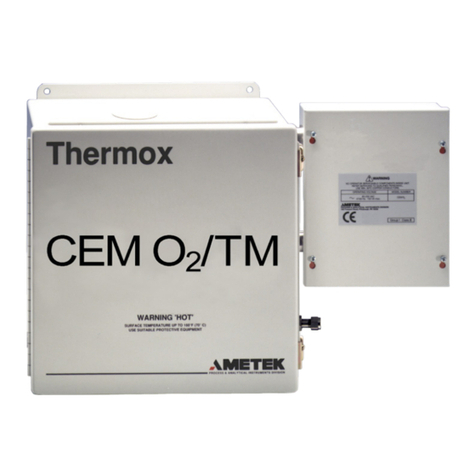
Ametek
Ametek Thermox CEM O2/TM user manual

Fuji Electric
Fuji Electric NRF54 user manual
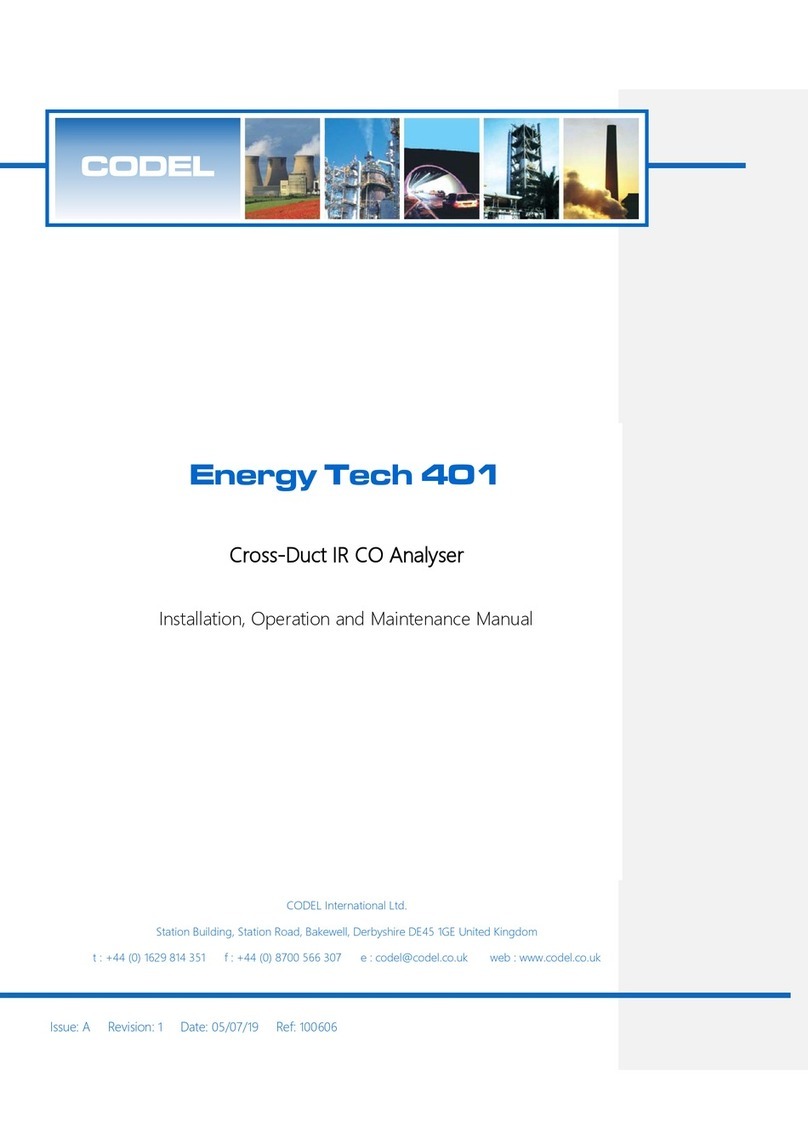
CODEL
CODEL Energy Tech 401 Installation, operation and maintenance manual

International Light Technologies
International Light Technologies ILT5000 instruction manual

Minder Research
Minder Research EMGR819LR user manual
Inficon
Inficon Micro GC Fusion Installation sheet
